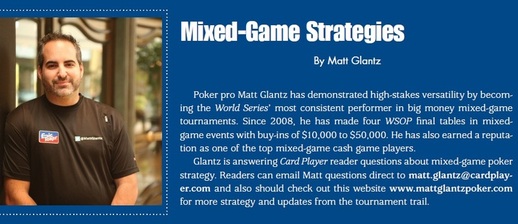






Mixed-Game Strategiesby Matt Glantz | Published: Oct 03, 2012 |
|
|

Q: Is it wrong to assume that someone has a boat every time the board pairs in Omaha? I’m tired of folding straights or flushes, only to be shown that I had the best of it. But then again, I don’t want to be the guy who calls everyone down drawing dead either.
A: It is very wrong to assume the board pairing in Omaha means that your opponent has a full house every time. What is not wrong is to assume that when the board pairs the likelihood of an opponent having a full house is much higher in Omaha than hold’em.
In general, when you have a straight or flush in Omaha and have taken the lead in the hand, it would be profitable to bet the next street even when the board pairs to put your opponent in a spot where he is going to define his hand to some degree.
Against all but the most talented and tricky Omaha players you can safely fold to a raise when you find yourself in that situation with a straight or a flush on a paired board.
Q: I just started playing five-card draw online and have a question about discards. Let’s say I’m dealt A-5-5-7-10 (or any low-to-mid pair with an ace) in the big blind or in a limped pot and get a free draw. Should I be keeping the ace with the fives or should I discard three, giving me a better shot at hitting trips? I feel that when I discard three, it tells everyone at the table that I have a pair and there is no deception. But if I only draw two, it may allow me to represent a stronger hand, such as dealt trips.
If you are not raising pre-draw there is no reason for any of your opponents to put you on trips. Would you ever just check from the big blind with a hand as strong as 5-5-5? The standard way to play your hand would be to draw three cards and keep the pair (don’t keep the ace). Your chances of hitting trips are approximately 50 percent greater when drawing three than when drawing two. That is significant enough that keeping the ace would be a big mistake.
If you want to get fancy and draw only two, you should be raising from the big blind and this way you can represent trips when you draw two. By taking this line you will most likely be better off betting post-draw when you miss and checking to call or fold when you improve. It seems counter intuitive but when you take this line of raising and drawing two your opponents will have to put you on trips and will probably fold most two-pair hands post-draw. They will also not be bluffing you very often since they will think you are already holding trips and not likely to lay down. This means that when they bet or raise they will most likely have trips beat.
Q: When playing high-low-high Chinese poker, is it better to be more balanced, with three decent hands, or give up on one to make two very strong hands and one very weak hand?
There is no answer to your question that will cover every hand. This depends on the cards you are dealt. The way to think about any Chinese poker hand, high or low, is to rank the hands you can make in the front, middle, and back. For simplicity sake we can rank each hand from 1-10 in each spot. So that if we can make three evenly ranked hands at say a value of 6, 7, 5 for a total of 18, this would be better than setting the hands unevenly at 8, 4, and 3 for a total of 15. But if we were able to set them unevenly at 10, 9, 1 for a total of 20 then we have found the optimal solution for our combination of 13 cards.
Q: Other than the value of the cards themselves, what are the major differences between ace-to-five and deuce-to-seven lowball? Should I be playing these games the exact same way?
The major difference in ace-to-five games versus deuce-to-seven games is that in deuce games, straights and flushes count against you. The best hand in ace-to-five is A-2-3-4-5 no matter what combination of suits. In deuce, the best hand is 2-3-4-5-7 because that is the lowest possible hand that does not make a straight (flushes also counts against you). When playing the deuce variant of lowball, a general concept you should be aware of is to not be drawing to hands that make straights. Hands such as 3-4-5 or 4-5-7 are not nearly as valuable as 2-3-7 or 2-4-8. These concepts are irrelevant in ace-to-five lowball where you are just trying to make the five lowest cards without pairing. ♠
Matt Glantz, Ambassador to Parx Poker Room (just outside Philadelphia, PA), is serving an integral role in the development of the fastest growing poker room on the East Coast. Matt has shown a consistent passion for growing the game of poker and has demonstrated high-stakes versatility, becoming the World Series’ most consistent performer in big money mixed-game tournaments. Since 2008, he has made four WSOP final tables in mixed game events with buy-ins of $10,000 to $50,000 and is considered one of the top mixed-game cash game players. For more strategy and updates from the tournament trail, check out www.mattglantzpoker.com
Features
The Inside Straight
Strategies & Analysis
Commentaries & Personalities